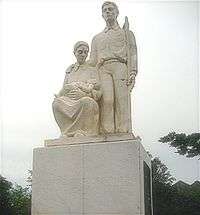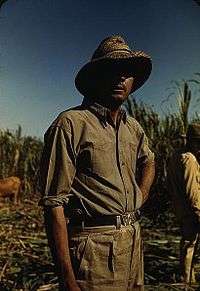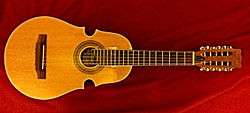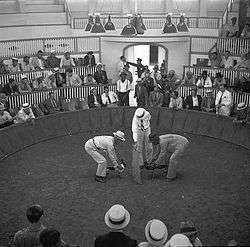Jíbaro (Puerto Rico)
Jíbaro (Spanish: [ˈxiβaɾo]) is a word used in Puerto Rico to refer to the countryside people who farm the land in a traditional way. The Jíbaro is a self-subsistence farmer, and an iconic reflection of the Puerto Rican people. Traditional jíbaros were also farmer-salesmen who would grow enough crops to sell in the towns near their farms in order to purchase clothing, etc., for their families.
Jíbaro | |
|---|---|
 Monumento al Jíbaro Puertorriqueño dedicated to the Jíbaro, in Salinas, Puerto Rico | |
| Nationality | Puerto Rican |
| Occupation | Self-subsistence farmers, agricultural land tenants, sharecroppers, fieldworkers |

In contemporary times, both white-collar and blue-collar Puerto Ricans are identifying themselves as jibaros in a proud connection with their Puerto Rican history and culture in general.
Historical context
As early as 1820, Miguel Cabrera identified many of the Jibaro's ideas and characteristics in his set of poems known as The Jíbaro’s Verses. Then, some 80 years later, in his 1898 book Cuba and Porto Rico, Robert Thomas Hill listed jíbaros as one of four socio-economic classes he perceived existed in Puerto Rico at the time: "The native people, as a whole, may be divided into four classes: the better class of Creoles, who call themselves Spaniards; the lower class of white peasantry, known as gibaros; the colored people, or mestizos; and the blacks."[1]
Under Operation Bootstrap, in the middle of the twentieth century, Puerto Rico experienced an island-wide shift from an agrarian to a cosmopolitan society. Industries incorporated cheap labor, which led to the migration of many Jíbaros from the mountain towns to the larger urban areas.[2]
Jíbaros had a significant impact on the culture, political life, and language of Puerto Rico. Jíbaros were viewed differently by different Puerto Ricans.[3]

In the political arena, when Luis Muñoz Marín ran for office, he often invoked the Jíbaro as a means of uniting the working class of Puerto Rico under a populist party. To his own political gain, he sought to represent them as possessing ideals of hard-working Puerto Ricans. Muñoz Marín also adopted as the symbol of his party the silhouette of a Puerto Rican farmer with a pava,[4] the straw hat that field laborers often wore. It served to bolster their image as that of a proud people who worked and toiled the land to earn an honest living. Simultaneously, Muñoz Marín developed as his party's motto the phrase "Pan, Tierra, Libertad" (Bread, Land, Liberty). Muñoz Marín himself, in an attempt to court the votes of the large segment of the electorate represented by the Jíbaro population, at times dressed like his portrayals of the Jíbaro. By idealizing the Jíbaro, Luis Muñoz Marín was also able to captivate the attention and goodwill of much of the cultural elite of Puerto Rico because many of them viewed Jíbaros as the "essence of the Puerto Rican soul". His campaign, in effect, portrayed the Jíbaro through a lens of whiteness, much like Manuel A. Alonso had done before.[5]
In 1941, Oscar Colón Delgado created Jíbaro Negro (black jíbaro) which represents a dark-skinned "jíbaro farmer".[6]
Andrés Jiménez, "el Jíbaro", a Puerto Rican troubadour, would work on changing that perception with his song describing "El Puertorriqueño" as having a dark skin tone.[7]
Social, family and work aspects
The jíbaro values and way of life are oftentimes associated with the rich heritage and positive culture of Puerto Rico, as well as with the authenticity, resourcefulness and craftsmanship of the Puerto Rican people. These values and way of life include a sense of community, family, and hospitality. From young, children were taught to contribute to the family by, for example, assisting with cleaning and cooking family meals, and for older children, by ironing their own school clothes and polishing their own shoes. Some children were encouraged to look for ways to make money in order to buy anything that was not deemed a “need”.[8] The values taught included respect for hard work, the importance of being resourceful, and an understanding of the values of unity, determination and integrity.[9]
Music

The Jíbaro "subculture" is also characterized by its own typical Puerto Rican folks music, commonly termed "Jíbaro music".[10] "Jíbaro music and dance was the principal musical expression of the humble and hardworking mountain people who worked the coffee plantations and inland farms of Puerto Rico."[11] This genre of music goes by different names, all of which refer to the same genre: typical music, mountain music, peasant music, Puerto Rican hillbilly music, or jibaro music.[12] Ramito is said to be the greatest proponent and interpreter of the jíbaro music.[13][12] Odilio Gonzalez, a singer of jíbaro music and original from the mountain town Lares, adopted the pseudonym of "El Jíbaro de Lares" (the Jíbaro from Lares), and published many LPs with the name proudly plastered prominently on their covers.
Jíbaro music is characterized by the use of the cuatro, guitar, and güiro. Maracas, bongos, congas and cowbells are also commonly used in addition to the three base instruments. There are 3[lower-alpha 1] sub-genres of the jíbaro music: seis (introduced by Spanish colonizers), aguinaldo (traditional Christmas songs), and corridos.[14][15] Jíbaro music is most commonly heard during the Christmas season, but it is also played at weddings, birthdays, and at fiestas patronales throughout the year.[16]
| External audio | |
|---|---|
Food
Plantains were the jibaro's "daily bread", and its mature fruit could serve as bread and the unripe fruit could be eaten roasted or baked.[17] Many other foods are derived from plantains, including today's mofongo, maduros, and tostones, and plantains are also a base ingredient in pasteles.
Much of what is commonly considered authentic Puerto Rican food today actually had its roots in the foods typically prepared and consumed by the jíbaro Puerto Rican of the mountain countryside. "mountains in the countryside, authentic food and jíbaro music go perfectly together."[18] The Jíbaro mode of preparation also differed from how today's authentic Puerto Rican foods are prepared, as Jíbaros prepared their food making regular use of stone stoves and rod-grilled (known as a la varita).[19]
Some of the more common traditional dishes are Asopao (a thick soup of rice and chicken), pasteles and mofongo.[20] Some jíbaro songs tell of jíbaros consuming "viandas and bacalao" as one of their daily staples.[lower-alpha 2][21][22] When jibaros settled on coastal town, some variations of their original foods developed, for example, asopao was then also made with seafood instead of chicken. Plantain, a common cultivar in the jíbaro residential fincas (farms), was the basis of various dishes or side dishes, such as tostones.[23]
Language
An 1887 document titled "Manifestaciones del elemento español de Puerto Rico con motivo de los sucesos de Juana Diaz, Puerto Rico 1887" (Instances of the Spanish element in Puerto Rico as it relates to the events in Juana Diaz, Puerto Rico 1887), speaks of the jíbaro language when it states "...'Los Secos' querían matar a todos los peninsulares y que ese [Celestino Aponte, representative of the Republic of Puerto Rico in Aibonito] ha recogido un documento escrito en jíbaro que no ha sido posible desifrar. (...'Los Secos' sought to kill all the Penisulares and that him [Celestino Aponte, representative of the Republic of Puerto Rico in Aibonito] has picked up a document written in jíbaro which has not been possible to decypher.)[24]
Clothing
Jose A. Mari Mut tells us that the traditional clothing of jíbaro men consisted of a long-sleeved white shirt and white pants, a fringe-less hat, and no shoes. According to him, the jíbaro woman ("jíbara") would also usually dress in white with a long shirt, shoulders and neck often covered, and would sometimes wear a hat or a bandana as a hair cover. She, too, would wear no shoes. The custom of not wearing shoes was not associated with poverty. Many instances of jíbaros were documented by American photographer Walter B. Townsend—both in writing and via his photographs—who were adequately dressed but wearing no shoes. The custom is thus attributed to comfort and convenience. Young jíbaro toddler boys would oftentimes be seen at their home naked, even while the jíbaro family hosted visitors. But the notion that this custom was also true for girls, or that jíbaro boys went to school naked, was debunked by over 3,000 pictures that Townsend took throughout Puerto Rico in 1900.[25]
Entertainment

A jíbaro's almost exclusive form of entertainment was cock-fighting. The pastime was performed mostly on Sunday afternoons, but saint days, feast days, or any other festive holidays would bring out particularly huge crowds to the event. Every town in Puerto Rico would have at least one cock-fighting pit. The upper classes of society would sometimes come to one of these events, but would not ordinarily be participants. Unlike the birds in the United States which were outfitted with metal razor-sharp blades strapped to their legs, Puerto Rico jíbaros fought their cocks with their own gaffs.[26]
Occupations
Many jíbaros were self-subsistence farmers, but there were also those who owned no land but instead worked as agricultural land tenants, sharecroppers, and fieldworkers of various types.[27] Some of those that did own their own plot of land would were also farmer-salesmen who would grow enough crops to sell in the towns near their farms in order to purchase clothing, etc.. Their crops would consist of whatever the land would grow: bananas, plantains, avocados, ñames, yautías, batatas, yucas, malangas, apio, etc. However, chickens, hens, eggs, and even charcoal were also traded.[28]
Political participation
The Jibaro population was also the main component of many of the struggles against the ruling colonial powers in the Island. They were the primary driving force in revolutions in Puerto Rico against the Spaniards, including the well-known 1868 Grito de Lares (Cry of Lares). Even after that revolution failed, the Jíbaro were credited with keeping the spirit of Puerto Rican freedom alive through other revolts including the 1897 Intentona de Yauco. After the Americans became the new colonial power in Puerto Rico in 1898, many Jíbaros organized Bandas Sediciosas (Seditious Bands) to protest American colonial rule. Jíbaros continued their struggle against American rule in Puerto Rico via the 1930s armed clashes of members of the Nationalist Party of Puerto Rico against the repressive police forces of the colonial regime and via the Nationalist Party's revolts of 1950.[29]
Modern usage of the word

Since at least the 1920s[30] the term "jíbaro" has had a more positive connotation in Puerto Rican culture, being now associated with a proud cultural heritage passed down to contemporary generations by the first brave settlers of the Puerto Rican interior mountains and countryside.[31] However, the term occasionally also has a negative connotation. A jíbaro can mean someone who is considered ignorant or impressionable due to a lack of a more formal form of education, as are many country or "hillbilly" people of several other countries.[32] Despite this negative connotation, the primary image is now that of the a person representing the idea of a "traditional Puerto Rican": simple but hard-working, independent but prudently wise. Colloquially, the jíbaro imagery serves as a representation of the roots of the modern day Puerto Rican people and symbolizes the strength of traditional values such as living simply and properly caring for the family and the homeland.[33]
In popular culture
There are many songs about the Puerto Rican jíbaro or, more dearly, the jíbarito, the diminutive of jíbaro. Lamento Borincano by Rafael Hernandez is one of them. Others are "Aguinaldo Jibaro" by Los Pleneros de la 21 & El Quinteto Criollo; El Jibarito Bruto (Seis Villaran) and Un Jíbaro Bueno, both by Chuito el de Bayamon (aka, "El Decano de los Cantores"); Jibarita de mi Tierra by Andres Jimenez; Un Jibaro en San Juan and Negando Su Idioma, both by Odilio Gonzalez.
Uses of the word in other countries
- In Cuba there exists a word similar to jíbaro, Guajiro.[34]
- In Colombia, Brazil and Venezuela, Xivaro, or Gibaro, which is pronounced similar to jíbaro, was a name given to the mountain natives of mentioned countries by the Spaniards and Portuguese.[35]
- In Ecuador, givaro is the indomitable indigenous or country persons who are endlessly elusive to the white man.[34]
- In Peru, the word jíbaro refers to country or mountain inhabitants.
Further reading
- Stavans, Ilan, Latin Music: Musicians, Genres, and Themes. ABC-CLIO. 2014. ISBN 0313343969 [Book]
- El Jibaro. Puerto Rico Off The Beaten Path. Page 157. Accessed January 16, 2011.
- Puerto Rico: la gran mentira. 2008. Uahtibili Baez Santiago. Huana Naboli Martinez.
- Francisco Lopez Cruz, "La Music Folklorica de Puerto Rico", Troutman Press 1967. [Book]
- Smithsonian Folkways, "Puerto Rico in Washington", 1989. [CD]
- Paquita Pescador de Umpierre, "Manual de Bailes Folkloricos", Editorial Universitaria, Universidad de Puerto Rico, 1981. [Book]
- Manuel Alvarez Nazario. El Habla Campesina Del Pais / The Peasant Language of the Country: Origenes Y Desarrollo Del Espanol En Puerto Rico / Origins and Development of the Spanish Language in Puerto Rico. La Editorial, UPR. 1990.ISBN 978-0-8477-3635-5.
External links
- La construcción literaria de la identidad de Puerto Rico: El país de cuator voces. Lisa Ybonne Figueroa Parker. University of Tennessee, Knoxville.
The Graduate School at Trace: Tennessee Research and Creative Exchange. Doctoral Dissertation # l5-2013. May 2013.
See also
| Spanish Wikisource has original text related to this article: |
Notes
- The "Proyecto El Cuatro" categorizes jíbaro music into four sub-genres: Décima, Seis, Aguinaldo, and Villancico. (See: El Proyecto del Cuatro, "Música" Section, at http://cuatro-pr.org/es/node/14 .)
- viandas are a generic name for starchy root vegetables, including ñame, yautía, batata, yuca, malanga, and the Puerto Rican apio, all locally grown in the mountain regions of the Island
References
- Hill, Robert Thomas (2 July 1898). "Cuba and Porto Rico, with the other islands of the West Indies; their topography, climate, flora, products, industries, cities, people, political conditions, etc". New York, Century. – via Internet Archive.
- Cruz-Janzen, Marta I. (2003). "Out of the Closet: Racial Amnesia, Avoidance, and Denial - Racism among Puerto Ricans". Race, Gender & Class. 10 (3): 64–81. JSTOR 41675088.
- Del Valle Atiles, Francisco (1889). "El Campesino Puertorriqueño Sus Condiciones Físicas, Intelectuales y Morales, Causas que la Determinan y Medios Para Mejorarlas". Gutenberg (in Spanish). Retrieved 6 July 2020.
- LAS ELECCIONES DE 1964 EN PUERTO RICO: UNA EVALUACION. ROBERT W. ANDERSON. Revista de Ciencias Socisles. Vol IX. Num 3. September 1965. Universidad de Puerto Rico. p. 263. Accessed 2 August 2019.
- Cordova, N (2005). "In his image and likeness: The Puerto Rican jíbaro as political icon". Centro Journal. 17 (2): 170–191.
- "Jíbaro Negro - Oscar Colón Delgado". Google Arts & Culture. Retrieved 8 November 2019.
- "El Gíbaro de Manuel Alonso: análisis de la identidad puertorriqueña". José Israel Negrón Cruz (in Spanish). Retrieved 20 July 2019.
- Unapologetically Jibaro. Mariela Oyola-Brauch. Culebra Ventures. 2017. Accessed 9 December 2018.
- Definición de Jíbaro. Venemedia Comunicaciones. 27 September 2018. Accessed 9 December 2018.
- History, Styles and Influence of Puerto Rican Music. Tijana Ilich. 24 November 2017. Accessed 8 December 2018.
- Seis Chorreao. Puerto Rican Folkloric Dance. 2018. Accessed 9 December 2018.
- Latin Roots: Jibaro Music is Puerto Rican Country Music. Quique Domenech. National Public Radio. 27 February 2014. Accessed 8 December 2018.
- Florencio Morales Ramos: Ramito, “el Cantor de la Montaña”. David Morales. Our Country Music. Not dated. Accessed 8 December 2018.
- La Música Típica Campesina ante los Tiempos de Crisis. Daliana Rosario. Radio Universidad de Puerto Rico. Accessed 8 December 2018.
- Jibaro Genre. Accessed 8 December 2018.
- La Musica Tipica Campesina ante los Tiempos de Crisis. Daliana Rosario. Radio Universidad de Puerto Rico. Accessed 8 December 2018.
- Guillermo A. Baralt. Buena Vista: Life and work in a Puerto Rican Hacienda, 1833-1904. Translated from the Spanish by Andrew Hurley. (Originally published in 1988 by Fideicomiso de Conservación de Puerto Rico as La Buena Vista: Estancia de Frutos Menores, fabrica de harinas y hacienda cafetalera.) 1999. Chapel Hill, North Carolina, USA: University of North Carolina Press. p. 26. ISBN 0807848018
- Jibaro music in restaurants across the countryside. Puerto Rico is Music: Tourism from another perspective. 14 November 2014. Accessed 17 December 2018.
- Jibaro music in restaurants across the countryside. Puerto Rico is Music! Tourism from another perspective. 14 November 2014. Accessed 8 December 2018.
- Puerto Rico, U.S.A. U.S. Department of Commerce. U.S. Government Printing Office. U.S. Government. Page 3. 1980.
- Raíces y Tubérculos. Centro de Recursos Informativos Digitales Agrícolas de Puerto Rico (CRIDAg). University of Puerto Rico at Mayaguez. 2018. Accessed 8 December 2018.
- "Cafe con Pan", In "Plena Con Lelolai, by Andres Jimenez, El Jíbaro. 2011.
- Food and Drinks. Magaly Rivera. Welcome to Puerto Rico. Accessed 8 December 2018.
- Eduardo Neumann Gandía. Verdadera y Autentica Historia de la Ciudad de Ponce. 1913. Reprinted in 1987 by Instituto de Cultura Puertoriqueña. p. 239.
- El Libro y La Gente. Las fotos de Puerto Rico en 'Our Islands and Their People'. Jose A. Mari Mut. 2013. Vol I, pages 4-5. (Digital version page 4.)
- William Dinwiddie. Cock-fighting in Puerto Rico. Harper's Weekly. Vol 52, No. 2189, p. 1174. 3 December 1898.
- Man in a sugar-cane field during harvest, vicinity of Rio Piedras, Puerto Rico. Jack Delano. Library of Congress. Prints and Photographs Division. Washington, D.C. December 1941. Accessed 10 December 2018.
- Odilio Jimenez. Un Jíbaro en San Juan. Accessed 10 December 2018.
- Castanha, T (2011). "The Modern Jibaro". The Myth of Indigenous Caribbean Extinction: 89–107.
- Puerto Rico, Antonio Paoli y España: Aclaraciones y Críticas. Archived 25 February 2014 at the Wayback Machine Néstor Murray-Irizarry. Footnote #26 (José A. Romeu, "Recordando noches de gloria con el insigne tenor Paoli", El Mundo, 31 de noviembre de 1939. p. 13) Ponce, Puerto Rico. Retrieved 27 April 2013.
- ¡Un agricultor de nueve años de edad! Carmen Cila Rodríguez. La Perla del Sur. Ponce, Puerto Rico. 27 July 2011. Retrieved 12 October 2011.
- ""Jibaro". Complimentary or Derogatory?". prezi.com.
- ¡Un agricultor de nueve años de edad!: Carlos Emanuel Guzmán, un jíbaro de nueva estirpe. Carmen Cila Rodríguez. La Perla del Sur. Ponce, Puerto Rico. Year 29, Issue 1443. 27 July 2011. Page 6. Retrieved 12 October 2011.
- Enrique Vivoni Farage and Sylvia Álvarez Curbelo. Hispanofilia: Arquitectura y Vida en Puerto Rico, 1900–1950. San Juan, Puerto Rico: Editorial de la Universidad de Puerto Rico. 1998. Page 258. ISBN 0-8477-0252-9.
- Maurizio Gnerre. Jivaroan linguistic and cultural tradition: an Amazonian-Andean sedimentation (Word Document). Università degli Studi di Pavi